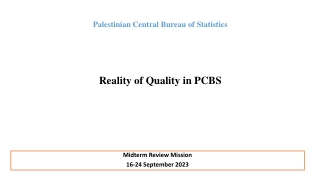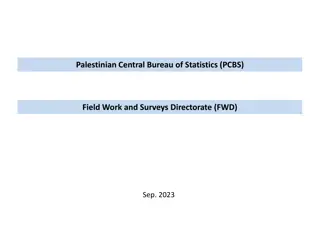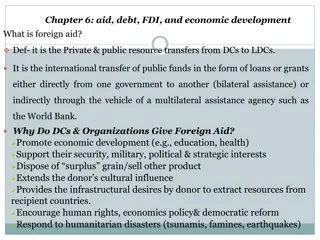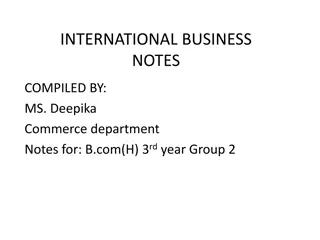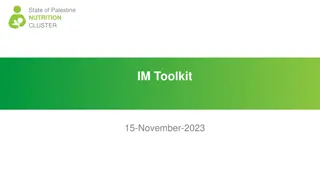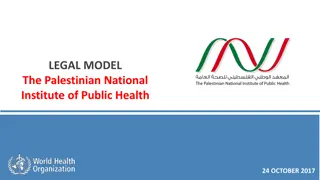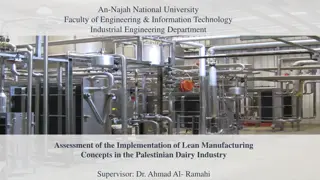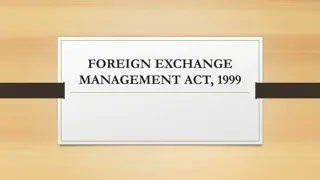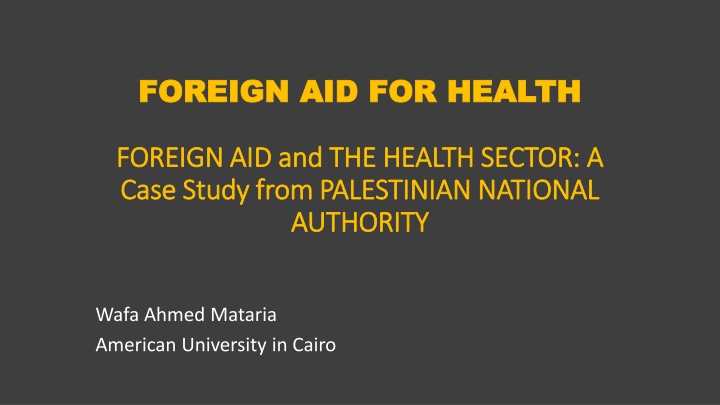
Foreign Aid for Health in Palestine: A Case Study from Palestinian National Authority
This case study explores the role, management, and challenges of foreign aid in the health sector of Palestine since the establishment of the Palestinian National Authority. It delves into how foreign aid is allocated, managed, and its effectiveness in enhancing health outcomes. Research questions, conceptual framework, and methodology are outlined to provide a comprehensive analysis of the impact of foreign aid on Palestine's health sector.
Download Presentation

Please find below an Image/Link to download the presentation.
The content on the website is provided AS IS for your information and personal use only. It may not be sold, licensed, or shared on other websites without obtaining consent from the author. If you encounter any issues during the download, it is possible that the publisher has removed the file from their server.
You are allowed to download the files provided on this website for personal or commercial use, subject to the condition that they are used lawfully. All files are the property of their respective owners.
The content on the website is provided AS IS for your information and personal use only. It may not be sold, licensed, or shared on other websites without obtaining consent from the author.
E N D
Presentation Transcript
FOREIGN AID FOR HEALTH FOREIGN AID FOR HEALTH FOREIGN AID and THE HEALTH SECTOR: A FOREIGN AID and THE HEALTH SECTOR: A Case Study from PALESTINIAN NATIONAL Case Study from PALESTINIAN NATIONAL AUTHORITY AUTHORITY Wafa Ahmed Mataria American University in Cairo
FA was introduced in the 1960s to alleviate poverty and ameliorate the quality of life and promote development. International aid is one of the most powerful weapons in the war against poverty (UNDP, 2005)
Since the 1970s, following the Alma Atta Declaration of 1978, health gained considerable attention as a precursor and as an end for the development process Increasing amounts of FA is directed to health initiatives. Between 2000 and 2015, FA for health increased from USD 2,208.98 million to USD 6,077.1 million. The increased flow of FA for health was accompanied with an international expectation for better health outcomes
Effectiveness of Foreign aid in development as well as in health is inconclusive
Research Question: Research Question: Main research question: What are the roles of FA on the Health Sector (HS) in Palestine, since the establishment of the Palestinian National Authority? Research sub-questions: 1. How is FA to the HS in Palestine allocated and managed? 2. What are the challenges facing the FA process in the HS in Palestine? 3. What measures are needed to enhance FA effectiveness in Palestine?
Conceptual Framework: Conceptual Framework:
Methodology: Methodology: Aim of the study: the study is exploratory and descriptive in nature it aims at deepening the understanding of the FA process in Palestine through concentrating on FA s : role, management, challenges in the HS in Palestine Approach: Quantitative descriptive approach quantitative explorative approach method: case study Data collection: OECD, World Bank WHO and PCBS data Desk review of published literature Semi-structured interviews Sampling: Purposive sample; Snowballing Analysis: 1. 2. descriptive analysis content analysis
Palestine and Foreign Aid Palestine has been in a conflict for almost a century now. War and struggle resulted in totally disjoint Palestinian territories and rendered Palestine to be an aid dependent country.
Health in Palestine Today, there are four health care providers in Palestine: MoH, NGOs, UNRWA, and private sector Total current expenditure on health constitutes 10.7% of GDP (2014) Government contribution is 43.1% while FA covers 4.4%
Israeli occupation British mandate PNA High unemployment High poverty Fragile economy FA dependency Palestine Today 1994 1948 NGOs Government FA
Net ODA to Palestine 2000 1800 1600 1400 Millions US Dollars 1200 1000 800 600 400 200 0 1994 1995 1996 1997 1998 1999 2000 2001 2002 2003 2004 2005 2006 2007 2008 2009 2010 2011 2012 2013 2014 2015 Year
FA to the health sector FA to the health sector Bilateral ODA by sector 2014- 2015
ODA to the health sector in Palestine ODA to the health sector in Palestine 16000 14000 12000 10000 USD Millions 8000 6000 4000 2000 0 1994 1995 1996 1997 1998 1999 2000 2001 2002 2003 2004 2005 2006 2007 2008 2009 2010 2011 2012 2013 2014 2015 Year
ODA distribution in health sector, Palestine 2015 Medical services 28.080 Health subdivisions Medical research 0.113 Medical education/training 1.657 Health policy & administrative management 3.340 0.000 5.000 10.000 15.000 20.000 25.000 30.000 Million USD
1. 1. Foreign Aid Foreign Aid role role on the HS in on the HS in Palestine Palestine FA contributed to the establishment of the institutional structure and capacities of the HS in Palestine Ability to formulate national health priorities and strategies The effectiveness of FA in Palestine has been improving due to Increased ownership and alignment FA has also helped in covering the expenses of service delivery
Now we have a homemade strategy and priorities, and there are more health facilities like hospitals and specialized facilities interviewee 4: describing the change in HS in relation to FA
2.Management & allocation of Foreign Aid for 2.Management & allocation of Foreign Aid for health health FA in Palestine is allocated and managed by the government according to: pre-identified needs and discussions between the donors and the different actors in the HS
3. Challenges facing FA effectiveness 1. Israeli occupation and the political situation Fragmented system No control over land & resources politicization of aid At times when the Palestinians get into peace negotiations with the Israelis, the amount of aid augments while in case of instability or disagreement with the international point of view of what should happen in Palestine (i.e. Hamas winning the election) the amount of aid decreases.
2. Donors influence a. FA to Palestine is still influenced by donors agendas, out of political obligations. The implementation of the strategy is donor driven it happens that we do not like some of the projects proposed by some donors, nevertheless we agree on them
b. The donors affect the relation between the MoH and local NGOs The government and the civil society are competing on control and resources MoH and NGOs compete for the same pool of FA Donors play a role in creating this competition through preferring certain funding routes over others implementing programs and projects: implementing through their agencies or through NGOs. budget support and direct donations to the government
3 3. Inadequate communication and coordination . Inadequate communication and coordination 1. Communication within and between different stakeholders is week Government: the communication between the concerned ministries and even between departments in the same ministry is week NGOs: good communication only between the most prominent NGOs Donors: separate initiatives of communications , nothing inclusive Communication between different actors is usually for information sharing only 2. The coordination structures There are three main coordination structures: ICD, LACS, PEGAS There is no obligation for coordination in any of these structures These structures seem to be isolated
4.Low 4.Low accountability of donors towards the recipients accountability of donors towards the recipients All parties were accountable towards the donors (MoH and NGOs) Donors were not accountable to either of them The discretion around the expenditure of donors augments the problem of reducing the drilldown to the Palestinian HS 5. The 5. The decrease in the amount of FA to decrease in the amount of FA to NGOs and volatility volatility NGOs and aid aid Donor fatigue lead to decrease in aid NGOs were left to suffer for their sustainability. After Oslo Accords, donors supported the two state solution and directed all their funds towards building the PNA.
Policy recommendations to improve FA Policy recommendations to improve FA effectiveness effectiveness Reconsideration of the priorities in the distribution of FA between different sectors Creation of an inclusive communication and coordination platform The administration of the HS and the provision of services ought to be separated from any political pressure A healthy competition atmosphere needs to be created Finally, donors need to push towards a political solution along with their aid for development
Thank You Thank You



